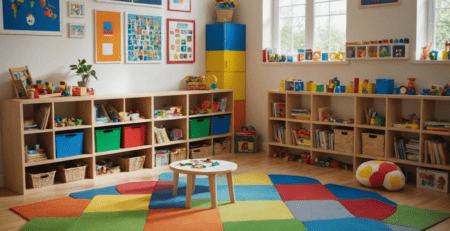
21
Begin Your Montessori School: A Step-by-Step Guide
Have you ever dreamed of starting your own school where children can experience hands-on, child-led learning in a nurturing environment? If so, starting a Montessori school may be the perfect venture for you. With its innovative educational approach and focus on individualized learning, Montessori schools have gained popularity around the world. In this article, we will explore the essential steps and considerations for starting your own Montessori school, from creating a vision and mission to obtaining the necessary certifications and finding the right location. Whether you’re a teacher, administrator, or passionate advocate for child-centered education, embarking on this journey will require dedication, research, and a deep commitment to the Montessori philosophy. So, let’s dive into the world of Montessori education and discover how you can bring this inspiring educational model to your community.
Table of Contents
- Considerations for Starting a Montessori School
- Developing a Business Plan and Curriculum
- Securing Funding and Location for the School
- Training and Hiring Montessori-Certified Staff
- Furnishing and Equipping the School Environment
- Marketing and Enrolling Students
- Q&A
- Insights and Conclusions
Considerations for Starting a Montessori School
Starting a Montessori school can be a rewarding and fulfilling endeavor, but it requires careful planning and consideration. Here are some key factors to keep in mind when embarking on this journey:
1. Understanding the Montessori Philosophy:
Before starting a Montessori school, it’s essential to have a deep understanding of the Montessori philosophy. This educational approach emphasizes independence, freedom within limits, and a hands-on learning environment. It’s important to align your vision for the school with these principles and ensure that all staff members are on board with this approach.
2. Creating a Well-Designed Learning Environment:
The physical environment of a Montessori school plays a crucial role in fostering children’s independence and self-directed learning. Consider implementing child-sized furniture, open shelving for materials, and natural lighting to create a calm and inviting space for students.
3. Obtaining Proper Accreditation and Licensing:
It’s imperative to ensure that your Montessori school meets all the necessary accreditation and licensing requirements. This may include obtaining certifications from Montessori accreditation organizations and adhering to state licensing regulations. Complying with these standards will not only enhance the credibility of your school but also ensure the safety and well-being of the students.
Developing a Business Plan and Curriculum
When starting a Montessori school, it’s essential to develop a strong business plan and curriculum to ensure the success and sustainability of your school. A well-thought-out business plan will help you define your goals, understand your target market, and outline your financial projections. It will also serve as a roadmap for how you will operate and grow your school over time. Likewise, a comprehensive curriculum is crucial for providing quality education and attracting parents and students to your school.
To develop a business plan for your Montessori school, consider the following key elements:
- Market Research: Understand the demand for Montessori education in your area and identify your potential competitors.
- Financial Projections: Estimate your startup costs, tuition fees, and ongoing expenses to ensure your school is financially viable.
- Marketing Strategy: Outline how you will promote your school and attract students and parents.
When it comes to creating a curriculum for your Montessori school, focus on the following areas:
- Montessori Method: Emphasize the core principles of Montessori education, such as individualized learning, mixed-age classrooms, and hands-on materials.
- Subject Areas: Define the subjects and learning areas that will be covered in your curriculum, such as language, math, science, and cultural studies.
- Enrichment Activities: Consider incorporating extracurricular activities, such as art, music, and physical education, to provide a well-rounded education for your students.
Securing Funding and Location for the School
When it comes to starting a Montessori school, securing funding and finding the right location are crucial steps. Without adequate funding, it can be challenging to get the school up and running, and without a suitable location, it can be difficult to attract students and staff. Here are some tips to help you navigate these important aspects of starting a Montessori school.
Securing Funding
1. Research grants and funding opportunities from organizations that support education and Montessori principles.
2. Consider crowdfunding campaigns to raise initial capital for the school.
3. Explore loans and financing options from banks and credit unions.
4. Seek partnerships with local businesses that are aligned with the Montessori philosophy and may be interested in supporting the school financially.
Finding the Right Location
1. Consider the demographic of the area and look for a location that is easily accessible to families with young children.
2. Look for a space that has ample outdoor area for children to explore and engage with nature.
3. Ensure that the location meets safety and zoning requirements for a school.
4. Consider the proximity of the location to other community amenities such as parks, libraries, and cultural institutions.
Training and Hiring Montessori-Certified Staff
1. Understand Montessori Certification Requirements
Before you begin the hiring process, it’s essential to have a clear understanding of the certification requirements for Montessori teachers. Research the different certification programs available and ensure that the candidates you consider meet these requirements.
2. Partner with Montessori Training Institutions
Reach out to Montessori training institutions and establish partnerships to facilitate the recruitment of certified teachers. These institutions often have qualified graduates who are seeking employment opportunities, making the hiring process more streamlined.
3. Provide Ongoing Professional Development
Once you have hired Montessori-certified staff, it’s crucial to provide ongoing professional development opportunities. This can include workshops, conferences, and mentoring programs to ensure that your staff stays updated with the latest Montessori teaching practices and methodologies.
Furnishing and Equipping the School Environment
- Child-sized Furniture: Invest in child-sized tables, chairs, and shelves that allow children to independently access materials and work comfortably.
- Natural Materials: Opt for furniture and materials made from natural and sustainable materials such as wood, cotton, and glass. This aligns with the Montessori emphasis on connecting children to nature and the environment.
- Open Shelving: Utilize open shelving and low, accessible storage units to display and store Montessori materials in an organized and visually appealing manner.
Creating a Montessori environment involves thoughtful consideration of every aspect, from the layout of the room to the selection of materials. By following these tips, you can ensure that your school environment is conducive to the Montessori method and supports the holistic development of every child.
Marketing and Enrolling Students
When starting a Montessori school, are crucial steps to ensure the success and sustainability of the institution. Here are some effective strategies to attract and enroll students in your Montessori school:
- Host Open Houses: Organize open houses to showcase the unique learning environment and philosophy of your Montessori school. This will allow prospective parents and students to experience the Montessori method firsthand.
- Build a Strong Online Presence: Create a professional website for your Montessori school and utilize social media platforms to engage with the community. Share testimonials, student success stories, and educational resources to showcase the value of a Montessori education.
- Participate in Community Events: Engage with the local community by participating in educational fairs, parenting workshops, and community events. This will help raise awareness about your Montessori school and attract potential students.
By implementing these marketing strategies, you can effectively promote your Montessori school and attract families who are seeking a unique and holistic educational approach for their children.
Q&A
Q: How do I begin the process of starting a Montessori school?
A: To start a Montessori school, you will need to research the state regulations for starting a school, create a business plan, and obtain the necessary funding and support.
Q: What are the key characteristics of a successful Montessori school?
A: A successful Montessori school emphasizes child-led learning, mixed-age classrooms, and a hands-on, sensory-based approach to education.
Q: How can I find qualified Montessori teachers for my school?
A: You can find qualified Montessori teachers through Montessori training programs, professional organizations, and networking with other Montessori school administrators.
Q: What are the steps to designing a Montessori curriculum?
A: Designing a Montessori curriculum involves considering the developmental stages of children, incorporating hands-on learning materials, and promoting independence and self-direction.
Q: How can I create a supportive and engaging learning environment for students?
A: To create a supportive and engaging learning environment, consider the layout of the classrooms, provide ample opportunities for movement and exploration, and promote a sense of community and respect among students.
Q: What are some common challenges in starting a Montessori school, and how can they be addressed?
A: Common challenges in starting a Montessori school include securing funding, recruiting qualified staff, and navigating state regulations. These challenges can be addressed through thorough planning, seeking out support and resources, and staying committed to the principles of Montessori education.
Q: What are some resources or organizations that can provide support to aspiring Montessori school founders?
A: There are several organizations and resources that can provide support to aspiring Montessori school founders, including the American Montessori Society, Montessori Administrators Association, and local Montessori training centers. These organizations offer training programs, networking opportunities, and access to educational materials.
Insights and Conclusions
In conclusion, starting a Montessori school can be an exciting and rewarding venture for educators and entrepreneurs. By embracing the Montessori philosophy, creating an enriching learning environment, and fostering a supportive community, you can set the stage for a successful and impactful educational institution. Remember to stay patient, adaptable, and committed to the ideals of Montessori education as you embark on this journey. With dedication and passion, you can create a space where children can thrive and develop into confident, independent learners. Wishing you all the best in your endeavor to start a Montessori school!










